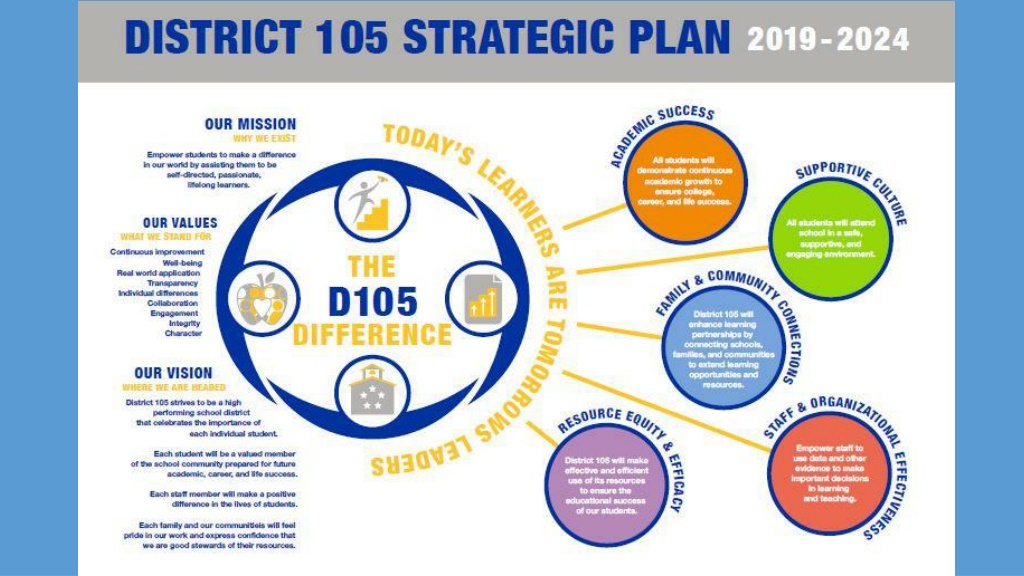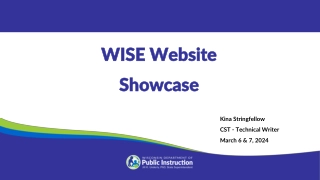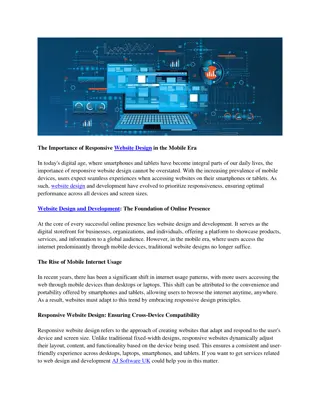
Tomorrow's Leaders: Empowering Learners for Success
Empower students to become self-directed, passionate, lifelong learners with a focus on continuous improvement, well-being, and real-world application. District 105 aims to create a high-performing school environment where each individual student is valued and prepared for future success academically, professionally, and in life.
Download Presentation

Please find below an Image/Link to download the presentation.
The content on the website is provided AS IS for your information and personal use only. It may not be sold, licensed, or shared on other websites without obtaining consent from the author. Download presentation by click this link. If you encounter any issues during the download, it is possible that the publisher has removed the file from their server.
E N D
Presentation Transcript
Todays learners are tomorrows leaders. Today s learners are tomorrow s leaders. OUR MISSION OUR VALUES Continuous Improvement Well-being Real world application Transparency Individual differences Collaboration Engagement Integrity Character Empower students to make a difference in our world by assisting them to be self- directed, passionate, lifelong learners.
Todays learners are tomorrows leaders. Today s learners are tomorrow s leaders. OUR VISION District 105 strives to be a high performing school district that celebrates the importance of each individual student. Each student will be a valued member of the school community prepared for future academic, career, and life success. Each staff member will make a positive difference in the lives of students. Each family and our communities will feel pride in our work and express confidence that we are good stewards of their resources.
Goal: Academic Success All students will demonstrate continuous academic growth leading to college, career, and life success. Strategy 1: Ensure fidelity of units of instruction implementation across the district. Further units of instruction in other content areas Continue to support grade level teams as they implement units of instruction Promote professional development aligned to instructional best practices to support unit instruction Continue coaching to support literacy and mathematics instruction Continue to support the arts, health, and physical education Examine differences in student subgroup populations and target closing gaps Ensures equitable learning experiences that build upon each other from grade to grade and school to school. Consider English language learners Consider low income students Consider students with disabilities Examine/explore bilingual programs Examine/explore early learning opportunities for all students Strategy 2: Close gaps in achievement to ensure all students grow, learn, and achieve. Explore Interdisciplinary opportunities Consider student choice, voice, interests, and ownership of their learning Examine/explore pathways for enrichment and acceleration of learning Maximize student engagement through real world, hands-on learning experiences Provide opportunities for authentic performance assessments Utilize technology purposefully, skillfully, and intentionally Strategy 3: Research, explore, and standardize impactful and engaging instructional practices.
Goal: Supportive Culture All students will attend school in a safe, supportive, and engaging environment. Strengthen Social Emotional Learning (SEL) practices Integrate SEL with life readiness competencies Consider new differentiated SEL instructional strategies Provide responsive, impactful, on-going SEL interventions Explore SEL opportunities and partnerships beyond the school day Consider other SEL personnel supports Strategy 4: Refine our systems of supports to ensure students social and emotional needs are being met. Build on recent academic curriculum (Units of Instruction) Consider new differentiated instructional strategies Minimize the impact of standardized testing and assessments on instructional time Validate all students are being challenged Provide responsive, impactful, on-going academic interventions Explore academic opportunities and partnerships beyond the school day Consider other schedule and personnel supports Strategy 5: Refine our systems of supports to ensure students academic growth and development needs are being met.
Goal: Family and Community Connections District 105 will enhance learning partnerships by connecting schools, families, and communities to extend learning opportunities and resources. Strategy 6: Strengthen unity and cross-cultural connections throughout the district. Build on marketing efforts (105 Difference) to increase the visibility of current district success Improve effectiveness in use of social media, website, technology Promote school-to-school networking and partnerships Strategy 7: Provide opportunities for families and the communities to extend learning opportunities. Form new strategic partnerships with organizations that can support and advance the district s mission and vision Support a foundation and/or other ways to impact innovation and continuous improvement Improve communication and collaboration that connects stakeholders to core mission, vision, values, and goals Increase engagement and educational opportunities Value and celebrate cultural differences throughout the communities Design service learning projects with community agencies, business, other organizations Explore career awareness and workplace competencies opportunities Explore mentoring opportunities Explore volunteer support Clarify family expectations in partnering to improve student growth
Goal: Staff and Organizational Effectiveness District 105 will make a difference in the success of each student by retaining, and cultivating a high-quality, diverse, collaborative staff. Use essential, critical data that is user friendly, accessible, and timely Foster data analysis through professional development, coaching, and effective use of technology Monitor student progress using data from units of instruction and school/district improvement goals Report performance that celebrates growth and improvement Report performance that targets improvement Strategy 8: Empower staff to use data and other evidence to make decisions that positively impact learning and teaching. Meet the individual and collective learning needs of the teaching and support staff Utilize and foster staff talents and skills Assist every staff member to be an effective member of a collaborative team. Align with district, school, or team goals/improvement plans Align with the formal evaluation process Recruit a pool of exceptional and diverse candidates to hire Design a two year induction and mentoring program that clarifies expectations for district mission, vision, values, goals and strategies. Strategy 9: Provide tools, opportunities, and resources to promote professional growth within schools, across schools, and outside of the district.
Goal: Resource Equity and Efficacy District 105 will make effective and efficient use of its resources to ensure the educational success of our students. Address enrollment patterns (class size) Evaluate and modify instructional spaces so they support today s learners Consider uniqueness and needs of various student subgroup populations Strive for curriculum equity Continue to address safety and security Consider staffing, programs and services to ensure equity of student needs being served Strategy 10: Establish resource equity across schools. Return to a balanced budget Eliminate deficit spending Develop a sustainable strategy for debt management Consider new revenue opportunities (grants and other) Ensure resources enhance the quality of programs and services for students Strategy 11: Develop a sustainable business plan.






















